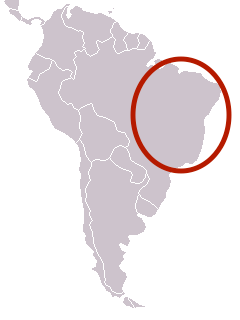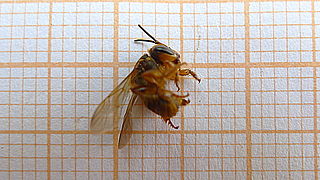
Schwarziana quadripunctata is a small, stingless bee found in a stretch of the South American Amazon from Goiás, Brazil, through Paraguay, to Misiones, Argentina. This highly eusocial insect constructs earthen nests in the subterranean level of the subtropical environment, an unusual feature among other stingless bees. The species ranges in sizes from 6.0 to 7.5 millimetres and feeds on a diverse diet of flowering plants found abundantly on the forest floor, including guacatonga and the mistletoe species Struthanthus concinnus.

Tetragonisca angustula is a small eusocial stingless bee found in México, Central and South America. It is known by a variety of names in different regions. A subspecies, Tetragonisca angustula fiebrigi, occupies different areas in South America and has a slightly different coloration.

Nannotrigona testaceicornis is a eusocial stingless bee species of the order Hymenoptera and the genus Nannotrigona. Its local common name is abelhas iraí. This species has a large geographic distribution and occupies different biomes, including urban areas, around Neotropical America. The bees of this species nest in trees or artificial cavities because of this broad distribution. N. testaceicornis is important for agriculture because it will pollinate a vast number of plant species year round.

Scaptotrigona postica is a species of stingless bee that lives mainly in Brazil. It is a eusocial bee in the tribe Meliponini. S. postica is one of 25 species in the genus Scaptotrigona and is a critical pollinator of the tropical rain forests of Brazil. They construct their nests in hollowed sections of tree trunks, allowing for effective guarding at the nest entrance. This species shows colony structure similar to most members of the Meliponini tribe with three roles within the colony: queen, worker, and male. S. postica individuals have different forms of communication from cuticular hydrocarbons to pheromones and scent trails. Communication is especially useful during worker foraging for nectar and pollen through the Brazilian tropical rain forests. S. postica is a very important pollinator of the Brazilian tropical rain forests and is widely appreciated for its honey. Stingless bees account for approximately 30% of all pollination of the Brazilian Caatinga and Pantanal ecosystems and up to 90% of the pollination for many species of the Brazilian Atlantic Forest and the Amazon.
Leurotrigona muelleri, commonly known as the lambe-olhos bee, is a species of small eusocial stingless bee in the family Apidae and tribe Meliponini.
Trigona dimidiata is a species of eusocial stingless bee in the family Apidae and tribe Meliponini.
Scaptotrigona bipunctata, also called tubuna in Brazil, is a species of eusocial stingless bee in the family Apidae and tribe Meliponini.
Scaptotrigona polysticta, called bijuí or benjoí in Brazil, is a species of eusocial stingless bee in the family Apidae and tribe Meliponini.
Tetragona clavipes, called borá or vorá in Brazil, is a species of eusocial stingless bee in the family Apidae and tribe Meliponini. In Brazil, it has been recorded in the northern state of Roraima.
Melipona interrupta, commonly known as jandaíra in Brazil, is a species of eusocial stingless bee in the family Apidae and tribe Meliponini.
Trigona amalthea, commonly known as jandaíra-preta or sanharão in Brazil, is a species of eusocial stingless bee in the family Apidae and tribe Meliponini.
Trigona branneri is a species of eusocial stingless bee in the family Apidae and tribe Meliponini.
Melipona quinquefasciata, commonly known as the mandaçaia-da-terra or mandaçaia-do-chão in Brazil, is a species of eusocial stingless bee in the family Apidae and tribe Meliponini.
Trigonisca duckei is a species of eusocial stingless bee in the family Apidae and tribe Meliponini.
Tetragona quadrangula, also called borá-de-chão in Brazil, is a species of eusocial stingless bee in the family Apidae and tribe Meliponini. It is endemic to Brazil.
Melipona compressipes, commonly known as tiúba in Brazil, is a species of eusocial stingless bee in the family Apidae and tribe Meliponini.
Geotrigona mattogrossensis is a species of eusocial stingless bee in the family Apidae and tribe Meliponini.

Scaura latitarsis is a species of eusocial stingless bee in the family Apidae and tribe Meliponini.
Scaura longula is a species of eusocial stingless bee in the family Apidae and tribe Meliponini.
Trigona chanchamayoensis is a species of eusocial stingless bee in the family Apidae and tribe Meliponini.





